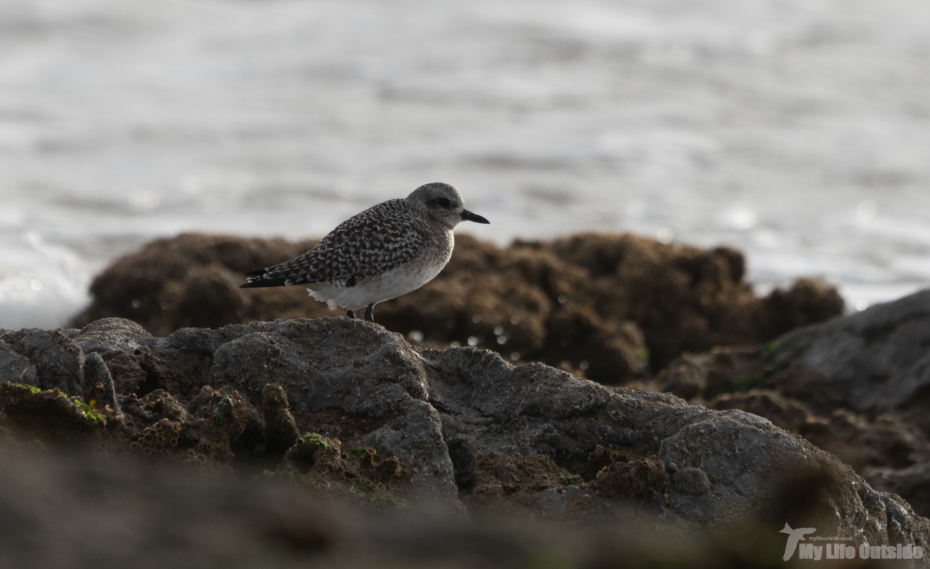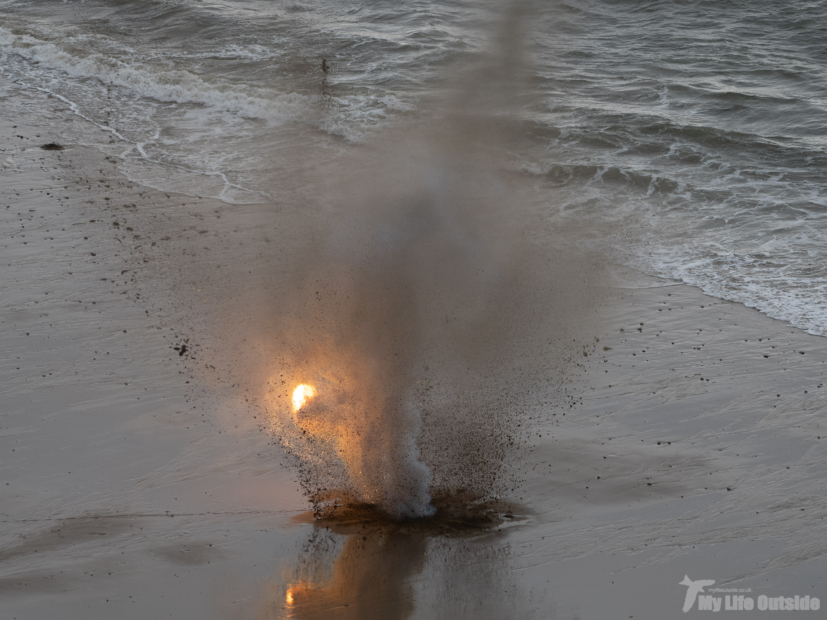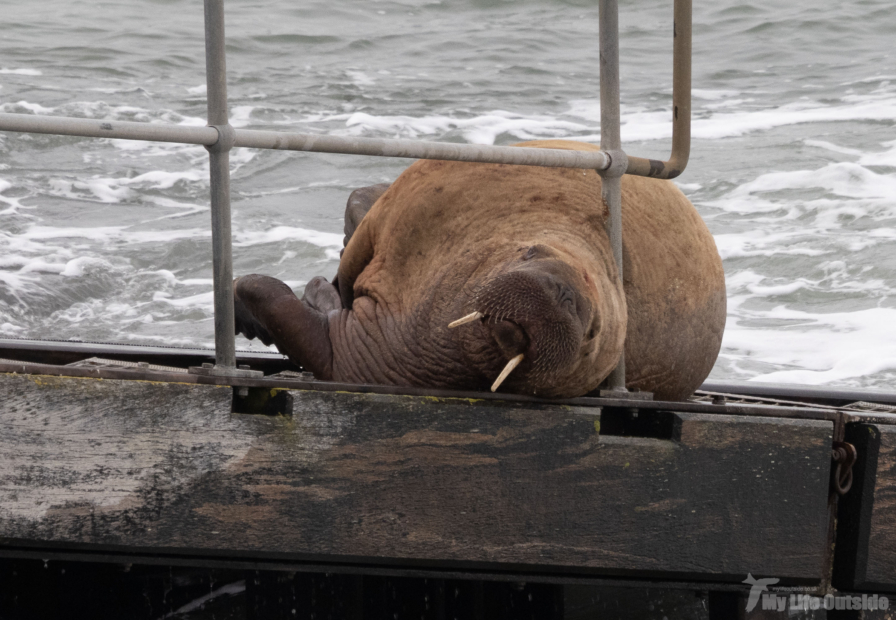The weather forecasts on Saturday were all pointing to large quantities of snow, but there was also unanimous agreement in the uncertainty of where exactly that snow was going to fall as snow and where it was going to fall as boring old rain. We were already on Gower when the question was answered for our particular locality; rain it was to be. A quick change of plan was implemented and we were soon driving inland up onto the Brecon Beacons. Almost immediately the rain turned to sleet and then snow and it wasn’t long before the scenery on all sides was white for as far as the eye could see. By the time we were up in the national park proper the snow had developed into a blizzard and was starting to settle on the previously clear road. Wanting to take it all in we carefully picked a lay-by that wasn’t covered in ice and got out to take a few photos, at which point the folly of not already wearing my boots became clear as my foot sank into an icy blanket of fresh wet snow.
Moving on we were soon at the start of the main path up to Pen y Fan, although we had no intention of climbing the peak itself given the severe conditions. Instead I wanted to explore the stream that comes off the mountainside in the hope that a few of the smaller waterfalls would have frozen over. Unfortunately it wasn’t quite cold enough for any of them to be fully solid, but the splashing water had certainly created some great icicles and ice formations.
Down in the forestry it was sobering to note that a couple of hardy souls were still trying to work through the worsening conditions. Their exertions were an effort to help stem the spread of Phytophthora ramorum, a fungus like pathogen that kills larch trees and which until 2009 was confined to the occasional garden outbreak. Since then the disease has been spreading rapidly due to its ability to create large quantities of infectious spores, and at present the only response is to fell infected trees. It’s increasing spread across Wales is a real cause for concern, and will no doubt mean that these impressive machines are not going to be short of work anytime soon.
Despite having only been up on the hills for an hour or so the main road was becoming ever more treacherous and we decided that it was wise to head back to lower ground. As we did so we passed the Beacons Reservoir, normally a vast expanse of water but today frozen almost solid and with a covering of snow that made it look like part of the hillside. Given that the windscreen washers on our car had frozen up and the wipers themselves were encased in ice it’s probably not hard to see why the reservoir was in the state that it was.
Things were unsurprisingly pretty quiet on the bird front but we did see another Woodcock flying over the road at Hirwaun whilst at the Storey Arms car park I got an opportunity to attempt my first ‘Robin in snow’ photo. Not the best I’m sure you’ll agree but it’s a start.
Back at home an hour watch of the garden had almost all of the regulars in attendance including the ever more frequent male Yellowhammer, a pair of Bullfinches and a marauding flock of Long Tailed Tits.












9 Comments
Bob Bushell · February 6, 2012 at 8:46 pm
Beautiful photography. What do you think of the snow? Mind you, we didn't get that much unlike others had!
Caroline Gill · February 6, 2012 at 9:23 pm
Your account, Adam, brings back memories of a similar 'Swansea to Brecon' expedition some years ago. Those icicles were incredible. We had just one small one, dangling from our balcony roof. The cormorants on the Orwell were crazily flying up and down, in competition, no doubt, for any stray fish. It's cold now, but melting bit by bit.
Unknown · February 6, 2012 at 10:21 pm
I had no idea of the existence of the fungus you mention in your post. It seems it had been introduced via imported plants but is it just in Wales or is it spreading further a-field? We need more trees; not less!
The trees in our woodland seem to be riding out the weird weather we have experienced over recent years but I am worried about the little moth which lays on Horse Chestnut trees. (Their larvae eat the green matter out of the leaves and the trees have a rusty complexion by mid-summer; mainly toward the lower branches).
Sondra · February 7, 2012 at 2:56 am
Hope they can control that fungus…the snowy photos are all awesome—Love the icicles!! Is a marvelous Robin in snow shot too!!
holdingmoments · February 7, 2012 at 1:28 pm
Great post Adam.
Looks like you are having some bad weather there. Always amazes me how the birds survive such conditions.
theconstantwalker · February 7, 2012 at 10:03 pm
Wonderful to see… but I am so glad I am not getting it..
Take care .. your images are great to see.
Dave · February 7, 2012 at 11:14 pm
love the drab tones that depict the overall wintery mood and then the icing on the cake with a splash of colour from the Robin right at the end
Adam Tilt · February 10, 2012 at 8:11 pm
Bob – thanks. I'm a big fan of the snow. Just wish we'd had a bit more of it!
Caroline – glad you haven't had it too bad over there. Snows all gone here now.
Bella – it's spreading far and wide I'm afraid. One good thing to come out of all this is that the forestry commission is replanting the felled areas with native trees that are resistant to the fungus. The result should be a much more diverse forest in a few years time.
Sondra – me too. Glad you enjoyed the photos.
Keith – thank you. Judging by the birds on our feeders humans are doing a lot these days to help them through the harsh weather.
Andrew – thanks. Will do.
Dave – cheers. It really was quite drab up there.
Unknown · February 12, 2012 at 8:13 pm
That could be here,but the snow isn't deep enough and you wear your boots from the house. Great shots!! Boom & Gary of the Vermilon River, Canada.